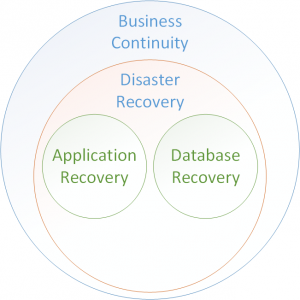- About
Getting to know us
- Services
- Managed Services
- Application Services
- Cloud Services
- Data Science
- Consulting Services
- Technology Solutions
Managed Services
Application Services
Data Science
Consulting Services
Technology Solutions
- Industries
- Resources
Resources
- Contact
- Contact us
What’s the difference between DB-RaaS and DRaaS?
Contents
What’s the difference between DB-RaaS and DRaaS?
What is Business Continuity?
Business continuity encompasses planning and preparation to ensure that an organisation can continue to operate in case of serious incidents or disasters and is able to recover to an operational state within a reasonably short period. That’s everything from providing offices and equipment, to staff, to ability to follow processes and procedures, to transaction things like stock as well as IT systems.
What is Disaster Recovery?
Disaster recovery involves a set of policies and procedures to enable the recovery or continuation of vital technology infrastructure and systems following a natural or human-induced disaster. Disaster recovery focuses on the IT or technology systems supporting critical business functions, as opposed to business continuity, which involves keeping all essential aspects of a business functioning despite significant disruptive events. Disaster recovery is therefore a subset of business continuity.
What is DRaaS?
Disaster Recovery as a Service (DRaaS) is the replication and hosting of physical or virtual servers by a third-party to provide failover in the event of a man-made or natural catastrophe. In the event of an actual disaster, an offsite “cloud” vendor will be less likely than the enterprise itself to suffer the direct and immediate effects, allowing the provider to implement the disaster recovery plan even in the event of the worst-case scenario: a total or near-total shutdown of the affected enterprise. Disaster Recovery also covers partial failures whereby the infrastructure underpinning a particular business application fails and there is a need to restore that application’s service while components are repaired.
What is DB-RaaS?
Database Recovery as a Service (DB-RaaS) is a database recovery service that utilises native database technologies to replicate transactions to a third-party database failover server. As the name suggests, the service focuses on database disaster recovery verses whole server recovery, which is covered by DRaaS. It can be thought of as a subset of DRaaS. The advantages of using such a service are…
- Certification and support of the database recovery process by the database software vendor
- Confidence that database consistency is maintained between your on premise Primary database server and the failover Cloud based database server without having to quiesce(1) the database
- The ability to configure your required recovery point and recovery time objectives (RPO and RTO) according to your business application’s needs
DSP's DB-RaaS for Oracle Database Enterprise Edition (ODEE)
Oracle Data Guard, a feature of ODEE, ensures high availability, data protection, and disaster recovery for enterprise data. Data Guard provides a comprehensive set of services that create, maintain, manage, and monitor one or more standby databases to enable production Oracle databases to survive disasters and data corruptions.
Data Guard maintains these standby databases as transactionally consistent copies of the production database. Then, if the production database becomes unavailable because of a planned or an unplanned outage, Data Guard can switch any standby database to the production role, minimizing the downtime associated with the outage. Data Guard can be used with traditional backup, restoration, and cluster techniques to provide a high level of data protection and data availability.
Data Guard Maximum Performance Mode
Data Guard offers three modes of operation. Maximum protection, maximum availability and maximum performance.
dsp's DB-RaaS for ODEE utilises the maximum performance mode. This protection mode provides the highest level of data protection that is possible without affecting the performance of the primary database. This is accomplished by allowing a transaction to commit as soon as the redo data needed to recover that transaction is written to the local online redo log. The primary database's redo data stream is also written to at least one standby database, but that redo stream is written asynchronously with respect to the transactions that create the redo data.
When network links with sufficient bandwidth are used, this mode provides a level of data protection that approaches that of maximum availability mode with minimal impact on primary database performance.
DSP's DB-RaaS for Oracle Database Standard Edition (ODSE)
The Standard Edition of Oracle’s database offering does not offer Data Guard as a licensed feature. To overcome this limitation and still provide the same level of service as its Enterprise Edition big brother, DSP deploys a product called DBvisit Standby which provides similar functionality.
Who would be interested in these services?
DRaaS and DB-RaaS can be especially useful for small to mid-size businesses that lack the necessary expertise to provision, configure and test an effective disaster recovery plan (DRP). Using these services also means the organisation doesn't have to invest in -- and maintain -- their own off-site DR environment. An additional benefit is that these types of contract can be flexible, as the business' needs change.
The downside is that the business must trust that the service provider can implement the plan in the event of a disaster and meet the defined recovery time and recovery point objectives.
(1) A database state that allows only DBA transactions, queries, fetches, or PL/SQL statements. Ongoing non-DBA transactions, queries, fetches, or PL/SQL statements are permitted while in this state; some databases queue the non-DBA transactions until the database is returned to its normal operational state.

.png?width=250&name=stonewater-logo%20(1).png)

